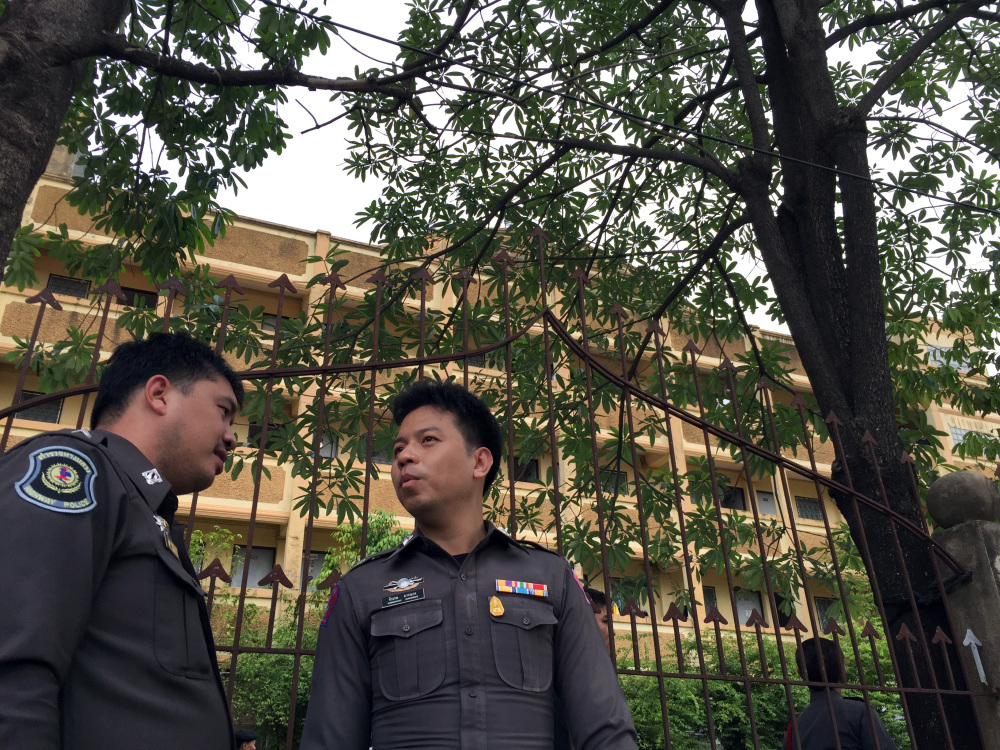BANGKOK — Thai authorities Saturday arrested a foreign man they said had been holed up in a suburban apartment with stacks of passports and bomb-making materials, the first possible breakthrough in the deadly bombing at a Bangkok shrine nearly two weeks ago.
Police and soldiers raided the suspect’s apartment in an eastern Bangkok suburb and then announced the arrest on all television channels Saturday evening. The arrest came 12 days after the bombing that authorities have called the most deadly attack in Thailand’s modern history.
National police spokesman Prawuth Thavornsiri described the suspect as a 28-year-old “foreign man” who was believed to have been part of a network that carried out the Aug. 17 blast at the Erawan Shrine in central Bangkok, which killed 20 people and injured more than 120, and another explosion the next day at a public ferry pier. The second blast caused no injuries but raised concerns about safety in the Thai capital, which draws millions of tourists.
“Our preliminary investigation shows that he is related to both bombings,” Prawuth said.
“We found parts of bomb-making materials, such as detonators” and a metal pipe, apparently meant to be used as a bomb, Prawuth said. “We also found a number of passports.”
Photographs taken at the apartment were shown during the broadcast, including one of stacks of passports that appeared to be Turkish.
Earlier, Prawuth said that authorities had not yet determined his nationality and dismissed Thai news reports saying he is Turkish. Images of a Turkish passport with the apparent suspect’s picture were posted on social media.
“The passport you see is fake,” said Prawuth, referring to the online photos. “We don’t know if he is Turkish or not.”
The blast at the Erawan Shrine was unprecedented in the Thai capital, where smaller bombs have been employed in domestic political violence over the past decade, but not in an effort to cause large-scale casualties.
The shrine is a popular tourist destination, particularly with Chinese visitors, who represent an important segment of the lucrative tourist market. At least six of the dead were from China and Hong Kong. It is located in a neighborhood full of upscale shopping malls and five-star hotels.
Soon after the bombing, police released an artist’s sketch of a man seen in a security camera video leaving a backpack at a bench then walking away from the open-air shrine. A separate camera showed the man, wearing a yellow T-shirt, on the back of a motorcycle taxi leaving the site.
The man seen in the video was believed to have carried out the bombing, which police said they believed was planned by a network. They indicated in Saturday’s news conference that the suspect arrested Saturday was not the bomber seen in the video.
“We believe he is a culprit in the same network. More details will be given later,” Prawuth said.
No one has claimed responsibility for the blast, sparking a variety of theories into who might be behind it.
Possible suspects include parties seeking to avenge Thailand’s forced repatriation of ethnic Uighurs to China, Muslim separatists from southern Thailand, opponents of Thailand’s military government and feuding factions within the security services.
Police have been criticized for releasing conflicting statements and rapidly hosing down the crime scene at the shrine before all forensic evidence was recovered. Many accused authorities of rushing to clean up the bomb scene to reassure the public – especially foreign tourists – that security in the city was back to normal.
Police say they have been handicapped by low-quality and broken surveillance cameras and a lack of sophisticated image-processing equipment to clarify the fuzzy images in security videos, which were the only firm evidence they had.
Send questions/comments to the editors.



Success. Please wait for the page to reload. If the page does not reload within 5 seconds, please refresh the page.
Enter your email and password to access comments.
Hi, to comment on stories you must . This profile is in addition to your subscription and website login.
Already have a commenting profile? .
Invalid username/password.
Please check your email to confirm and complete your registration.
Only subscribers are eligible to post comments. Please subscribe or login first for digital access. Here’s why.
Use the form below to reset your password. When you've submitted your account email, we will send an email with a reset code.